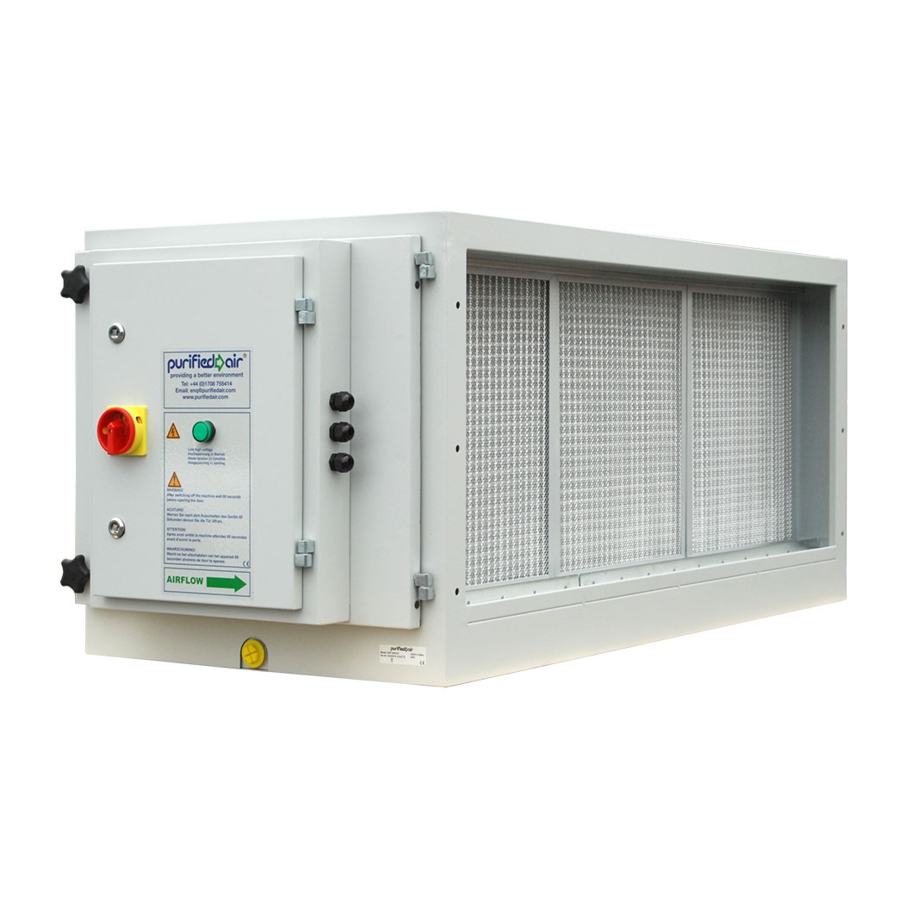
Summary of Contents for Purified Air ESP 3000
- Page 1 Electrostatic Precipitator ESP 1500 ESP 3000 ESP 4500 TECHNICAL & OPERATION MANUAL...
- Page 2 2011 All rights reserved. No part of this publication may be copied or published by means of printing, photocopying, microfilm or otherwise without prior written consent of the manufacturer. This restriction also applies to the corresponding drawings and diagrams. The information given in this document has been collected for the general convenience of our clients. It has been based on general data pertaining to construction material properties and working methods known to us at the time of issue of the document and is therefore subject at any time to change or amendment and the right to change or amend is hereby expressly reserved.
-
Page 3: Safety Instructions And Warnings
PREFACE Using this manual This manual is intended to be used as a work of reference for professional, well trained and authorised users to be able to safely install, use, maintain and repair the product mentioned on the cover of this document. Service and technical support For information about specific adjustments, maintenance or repair jobs which are not dealt with in this manual, please contact the supplier of the product. - Page 4 Intended use The product has been designed exclusively for use in commercial kitchens and for filtering harmful fumes which are released during the most common cooking processes. Using the product for other purposes is considered contrary to its intended use. The manufacturer accepts no liability for any damage or injury resulting from such use.
- Page 5 Never operate the product without filters. Do not use the product in areas with high concentrations of dry particulates (dust). Use of ESP 1500/ESP 3000/ESP 4500 for commercial kitchen extraction The product is suitable for the filtration of extracted fumes from commercial kitchens.
-
Page 6: Packaging Material
USED PRODUCTS AND THE ENVIRONMENT Packaging Material The purpose of the packaging is to protect the product during transport. It consists of the following substances that can be reused: - (corrugated) cardboard - untreated wood Do not dispose of the packaging material in the industrial waste Product Products which you would like to dispose of may still contain valuable substances and materials. -
Page 7: Technical Specifications
This electrostatic air cleaner can remove, at a high efficiency, small grease and soot particles that pass the grease filters. The ESP 1500/ESP 3000 is designed to be installed in the extraction ducting of a commercial kitchen downstream of the extraction hood. -
Page 8: Operation
Operation Figure 2.1 The extracted contaminated air passes the pre filter (A) that takes out all larger particles. The pre filter also ensures a proper distribution of the airflow. After that, the air passes the ioniser (B). The contaminations in the air are electrically charged by the high voltage (+10kV). These will then be deposited on the earthed plates (see fig. - Page 9 The final filter (4) is the last filtration step and it also spreads the airflow. There is an on/off switch (D) and a high-voltage indicator (E) on the control panel (see fig. 2.3). Please contact your dealer if the alarm light is illuminated. Regularly check the functioning of the indicator when using the product, since it indicates that the electrostatic filter is properly charged.
-
Page 10: Installation
(see fig 3.1A) as well as suspension by screw rods attached to the top of the ESP 1500/ESP 3000 unit (see fig. 3.1B). It is necessary to drill holes on the upper side for this purpose. It is also possible to place the unit on the ground. - Page 11 DIMENSIONS Dimensions ESP 1500/ESP 3000/ESP 4500 All dimensions in millimeters Do Not Scale T itle: ESP 1500 W eight: Power Supply: Air Flow 60kg 220/240v-50Hz-1 Phaze Maximum air flow through system: 0.7m³/s Service Space Note: If access equipment is necessary service requirements may vary.
- Page 12 All dimensions in millimeters Do Not Scale T itle: E S P 3 0 0 0 W eight: Power Supply: 100kg 220/240v-50Hz-1 Phaze Air Flow Maximum air flow through system: 1.4m³/s Plan 0.28 0.56 0.83 1.11 1.39 Air Capacity (m³/s) ESP 3000 Ai r Fl ow Front E levation...
-
Page 13: Periodic Maintenance
MAINTENANCE If you observe the necessary caution and carry out the simple maintenance and cleaning described below at regular intervals, then any problems will mostly be detected and corrected before they result in a total breakdown of the product. The indicated maintenance intervals can vary depending on the specific working and local conditions. - Page 14 It is a matter of experience to determine when the product needs to be cleaned, since the nature and the degree of pollution depend strongly on the particular situation, humidity, intensity of use, etc. Nevertheless, the filters should be cleaned regularly (every 1 weeks up to 4 months).
-
Page 15: Troubleshooting
A number of problems in the checklist below can also be caused by defects in the connected equipment. This manual only deals with problems and solutions directly related to the machine itself. ESP 1500/ESP 3000/ESP 4500 malfunctioning Problem Possible Cause... -
Page 16: Wiring Diagram
WIRING DIAGRAM... - Page 17 PRESSURE LOSS GRAPHS RESISTANCE AGAINST AIRFLOW ESP 1500 MAX AIRFLOW 0.69 (m AIRFLOW (m RESISTANCE AGAINST AIRFLOW ESP 3000 MAX AIRFLOW 1.38 (m AIRFLOW (m...
- Page 18 RESISTANCE AGAINST AIRFLOW ESP 4500 MAX AIRFLOW 2.08 (m AIRFLOW (m...





Need help?
Do you have a question about the ESP 3000 and is the answer not in the manual?
Questions and answers